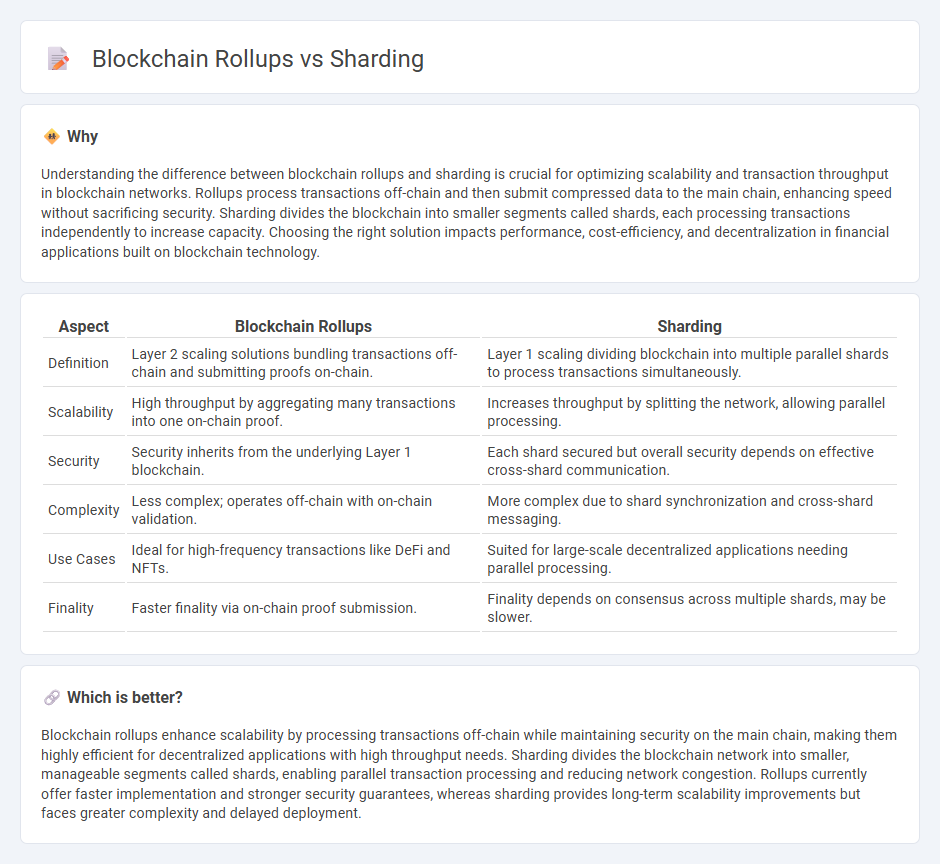
Blockchain rollups increase transaction throughput by processing data off-chain while maintaining security through on-chain data availability, enhancing scalability without compromising decentralization. Sharding partitions the blockchain into smaller, manageable segments called shards, allowing parallel transaction processing and data storage across nodes to boost network capacity. Explore how these cutting-edge technologies address scalability challenges and transform blockchain finance.
Why it is important
Understanding the difference between blockchain rollups and sharding is crucial for optimizing scalability and transaction throughput in blockchain networks. Rollups process transactions off-chain and then submit compressed data to the main chain, enhancing speed without sacrificing security. Sharding divides the blockchain into smaller segments called shards, each processing transactions independently to increase capacity. Choosing the right solution impacts performance, cost-efficiency, and decentralization in financial applications built on blockchain technology.
Comparison Table
| Aspect | Blockchain Rollups | Sharding |
|---|---|---|
| Definition | Layer 2 scaling solutions bundling transactions off-chain and submitting proofs on-chain. | Layer 1 scaling dividing blockchain into multiple parallel shards to process transactions simultaneously. |
| Scalability | High throughput by aggregating many transactions into one on-chain proof. | Increases throughput by splitting the network, allowing parallel processing. |
| Security | Security inherits from the underlying Layer 1 blockchain. | Each shard secured but overall security depends on effective cross-shard communication. |
| Complexity | Less complex; operates off-chain with on-chain validation. | More complex due to shard synchronization and cross-shard messaging. |
| Use Cases | Ideal for high-frequency transactions like DeFi and NFTs. | Suited for large-scale decentralized applications needing parallel processing. |
| Finality | Faster finality via on-chain proof submission. | Finality depends on consensus across multiple shards, may be slower. |
Which is better?
Blockchain rollups enhance scalability by processing transactions off-chain while maintaining security on the main chain, making them highly efficient for decentralized applications with high throughput needs. Sharding divides the blockchain network into smaller, manageable segments called shards, enabling parallel transaction processing and reducing network congestion. Rollups currently offer faster implementation and stronger security guarantees, whereas sharding provides long-term scalability improvements but faces greater complexity and delayed deployment.
Connection
Blockchain rollups and sharding are connected through their roles in enhancing blockchain scalability and transaction throughput. Rollups execute transactions off-chain while storing data on-chain, reducing congestion, whereas sharding divides the blockchain network into smaller segments or shards, enabling parallel processing of transactions. Both technologies work synergistically to increase network efficiency and lower costs in finance-related blockchain applications.
Key Terms
Scalability
Sharding partitions a blockchain into smaller, manageable segments called shards, each processing transactions independently to enhance scalability and throughput. Blockchain rollups aggregate multiple transactions off-chain and post compressed data on-chain, significantly increasing transaction speed while reducing costs without compromising security. Explore the advantages and limitations of both sharding and rollups to understand which method best suits scalable blockchain solutions.
Throughput
Sharding divides a blockchain network into smaller, manageable segments or shards, each processing transactions concurrently to significantly increase overall throughput. Blockchain rollups execute transactions off-chain and post compressed data to the main chain, enabling higher transaction throughput with minimal on-chain resource usage. Explore more to understand how these scaling solutions impact blockchain performance and efficiency.
Validity Proofs
Sharding and blockchain rollups both aim to enhance scalability, but differ significantly in their approach to validity proofs. Sharding partitions the blockchain into smaller, manageable shards, each maintaining its own state and validity proofs to ensure security, while rollups aggregate multiple transactions off-chain and submit a validity proof, such as zk-SNARKs, to the main chain for verification. Explore the detailed differences in how these methods utilize validity proofs to optimize blockchain performance and security.
Source and External Links
What is Sharding? - TechTarget - Sharding is a database partitioning technique that splits a large database into smaller, more manageable parts called shards, which operate independently and can be either horizontal (splitting rows) or vertical (splitting columns), enabling better performance and scalability within a shared-nothing architecture.
What is Database Sharding? - Shard DB Explained - AWS - Database sharding divides a dataset into partitions called shards, each with unique rows stored on separate machines called physical shards, which operate independently using a shard key to distribute data for scalable, parallel processing.
Understanding Database Sharding - DigitalOcean - Sharding breaks a large dataset into logical shards distributed across physical database nodes in a shared-nothing architecture, often implemented at the application level and aiding in scaling databases by isolating data access and reducing transactional load.
 dowidth.com
dowidth.com